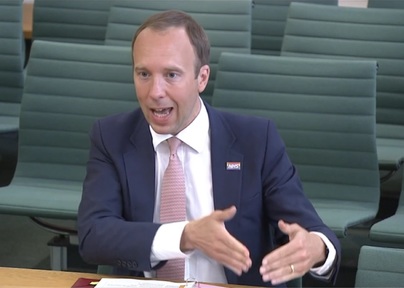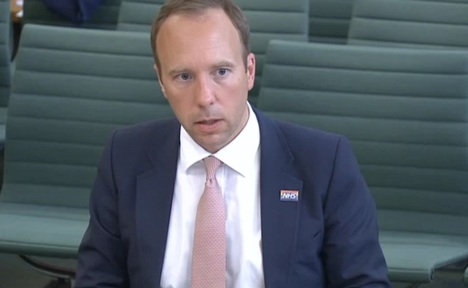Hancock says 'false negative' test fears led to infected hospital patients entering care homes
Health secretary Matt Hancock has told MPs concerns about false negative test results for asymptomatic patients and lengthy test turnaround times had led to Covid-infected hospital patients being discharged into care homes.

Mr Hancock has defended the government's decision early in the coronavirus pandemic not to test hospital patients entering care homes, saying he had been advised by clinicians that infection control in care homes and testing of care home staff were “the most important thing”.
He told MPs that he knew more testing capacity was needed in his evidence on 10 June to a joint session of the Health and Social Care Committee and Science and Technology Committee, which is looking into lessons learned from the pandemic.
His appearance before the joint committee, follows that of Dominic Cummings, the Prime Minister’s former chief adviser, who has made numerous allegations against Mr Hancock.
‘Not just that we didn’t have the testing capacity’
Greg Clark, chair of the Science and Technology committee, told Mr Hancock: “The third charge that Dominic Cummings specifically made, orally, against you was around testing in care homes.
“Did you tell the Prime Minister in March [2020] that people in hospitals would be tested before they went back into care homes?”
Mr Hancock replied: “I..we set out a policy that people would be tested when tests were available. And then I set about building the testing capacity to be able to deliver on that.“
“On care home policy throughout we followed the clinical advice.
“The challenge was not just that we didn’t have the testing capacity but also that the clinical advice was that a test on somebody who didn’t have any symptoms could easily return a false negative.”
Mr Hancock also said “the clinicians were worried that because it took four days to turn a test around, that if you leave somebody in hospital in those four days they might catch covid and therefore go back to a care home with a negative test result but having caught it”.
The health secretary said, as a result, the clinical advice given was that “the most important thing was infection prevention control in care homes and the evidence has shown that the strongest route of the virus into care homes, unfortunately is community transmission.
"And so, it was staff testing that was the most important thing for keeping people safe in care homes.
“And obviously again for that we needed the testing capacity.”
Labour MP Barbara Keeley told Matt Hancock: “Care England have told me that several care providers offered brand new care facilities that hadn’t been commissioned and could have been used for isolation, so if tests hadn’t come back in 24 hours they could have been used in that way.”
The minister said he could not recall care providers offering the use of care facilities.

Mr Hancock said the best estimate from Public Health England is that 1.6 per cent of the transmission into care homes came from hospital discharges.
However, committee chair Greg Clark said this was "a stretch of the imagination" as the data was not there to back this figure up because "people weren't tested."
The National Audit Office has said 25,000 people went untested from hospitals into care homes between mid-March and mid-April 2020, before the government changed its policy.
‘Each and every death in a care home weighs heavily on me’
Mr Hancock denied ever lying to the Prime Minister about testing and care homes.
Mr Hancock’s evidence follows a statement he made on 27 May this year, in which he said: “When it comes to the testing of people as they left hospital and went into care homes we committed to building the testing capacity to allow that to happen.”
But on 10 June, Mr Hancock admitted: “I knew we needed a radical increase in the testing capacity. A radical increase. And the incremental increases would not do.”
Greg Clark told Mr Hancock: “Discharging infected patients into care homes was...one of the major faults” in the first steps to handle the pandemic.
More than 40,000 deaths of care home residents in England and Wales have been linked to Covid-19, which flies in the face of Mr Hancock’s claim on 15 May 2020 that “Right from the start we’ve tried to throw a protective ring around our care homes”.
Committee chair Greg Clark asked Mr Hancock “What was that protective ring?”
Mr Hancock replied: “Well I think the most important words in that sentence was ‘we tried to’. It was very hard.
“All of these deaths in care homes, each and every death in a care home weighs heavily on me and always will."
We knew ‘from very early January’ care home residents were going to be at ‘particular risk’
“We knew from the start, from very early in January that the impact of this disease was most significant on the oldest and therefore care homes were going to be a particular risk, care home residents.”
When asked about lessons learned, Mr Hancock told MPs: “The need for a rapidly scalable testing operation must be part of pandemic preparedness and this country did not have one.
“The best thing to say is that government has operated better over the past six months."
Mr Cummings has said in his evidence to the joint committee last month: “The Secretary of State for Health should have been fired."
Mr Hancock said the government tried to protect residents with funding and "we made sure PPE was as available as possible”. This he called “a challenge” because the government had to build a PPE distribution system. He told MPs: "There was never a national shortage of PPE".
The minister also said that in terms of residents' protection “we set out guidance for care homes. The first guidance was on 25 February.
“And then later when we had the testing capacity in July we brought in the weekly testing of staff which is, I think, the single biggest improvement in terms of protecting residents.”
List of care homes: 'we didn't have one'
Mr Hancock also highlighted that care home residents and staff were put in the top priority for Covid vaccination.
The Secretary of State for Health and Social Care said that despite his job title, at the start of the pandemic “the powers I had over social care were extremely limited".
"The formal powers rest with local government.
"When I first asked for a list of all the elderly care homes, we didn’t have one.
“We need to reform social care. One of the reforms we need to make to social care is that more people should be discharged to their own home with a care package as a proportion, than into care homes.”
A full public inquiry is expected to be launched in the spring of 2022.
Latest News
 29-Jul-24
Dementia Bus gives carehome.co.uk staff insight into life with dementia
29-Jul-24
Dementia Bus gives carehome.co.uk staff insight into life with dementia
 01-Mar-24
Find out the top care homes in 2024
01-Mar-24
Find out the top care homes in 2024
 21-Mar-23
UK's top care homes in 2023 revealed
21-Mar-23
UK's top care homes in 2023 revealed
 03-Jan-23
carehome.co.uk launches free care helpline
03-Jan-23
carehome.co.uk launches free care helpline
 13-Dec-22
5 mins with Emily Whitehurst, chief operating officer for Constantia Healthcare
13-Dec-22
5 mins with Emily Whitehurst, chief operating officer for Constantia Healthcare